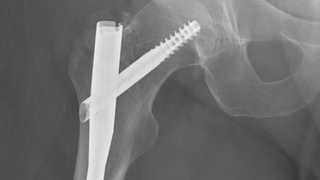Highly Experienced in Orthopaedic Trauma Care
Patients of all ages can experience trauma and fractures. These serious injuries can occur during auto accidents, life-threatening falls, and countless other scenarios. Unfortunately, they can have a long-term impact on patients’ functionality and even affect their quality of life.
UT Southwestern’s orthopaedic surgeons have pioneered surgical techniques and technology to improve results for patients who have experienced traumatic injuries.
One of our specialties is percutaneous fixation of pelvic fractures. Fractures of the pelvis and the acetabulum, a cup-shaped socket in the hip bone, are among the most serious injuries patients face. Often the result of a car accident or severe fall, these injuries require the rapid and precise treatment available at UT Southwestern.
Conditions
Bone fractures are extremely common, whether from high-energy trauma resulting in multiple injuries or from some other force or impact resulting in an isolated fracture and dislocation.
Our team expertly treats the full range of these injuries, no matter how complex, including long bone fractures of the upper and lower extremity. We also specialize in treating post-traumatic conditions such as malunions and nonunions (fractures that fail to heal properly) and osteomyelitis.
Trauma and Fracture Symptoms
Symptoms of a fracture or a post-traumatic orthopaedic condition can include:
- A clearly misshapen limb or joint, sometimes accompanied by broken skin or visible bone (an open or compound fracture)
- Fever
- Pain, ranging from mild to severe
- Restricted movement
- Swelling, bruising, tenderness, or numbness near the fracture
Diagnosis
Fractures and post-traumatic orthopaedic conditions are typically diagnosed with a combination of a physical examination and imaging.
Fractures are usually diagnosed using X-rays. Depending on the severity and location of the break or post-traumatic injury – and the extent of damage to surrounding tissue – other types of imaging might also be used to make a diagnosis. These include:
Other diagnostic testing might be used instead of or in addition to those tests. Identifying a bone infection, for instance, calls for blood work, while diagnosing a compressed nerve might require a nerve-blocking injection.
Treatments for Trauma and Fractures
Fractures of the pelvis, upper and lower extremities, and post-traumatic orthopaedic conditions can be treated with surgical and nonsurgical procedures, depending on the condition.
Common nonsurgical treatments include:
- Immobilizing devices such as casts, splints, braces, and traction
- Medications, such as antibiotics to resolve infections and nonsteroidal anti- inflammatory drugs to treat arthritis
- Physical medicine and rehabilitation
Surgery is sometimes necessary to properly treat breaks or trauma injuries that are complicated, severe, or resistant to healing. Surgical treatments include fixating (keeping together) the broken parts of the bone using metal pins, screws, or plates.
UT Southwestern orthopaedic medicine specialists work with each patient to choose a personalized treatment likely to have the best long-term outcome.
Clinical Trials
Our orthopaedics team is involved in clinical trials that seek to find a better way to prevent, diagnose, and treat bone fractures and post-traumatic orthopaedic conditions. See the latest clinical trials we’re conducting.









